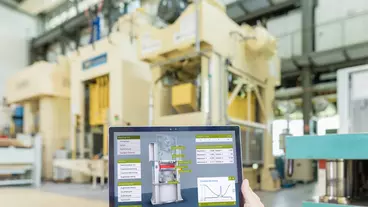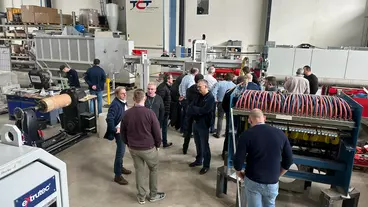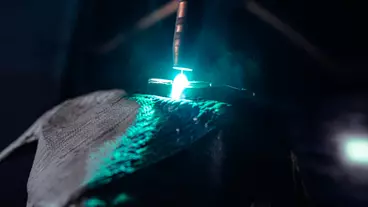A forming press goes Industry 4.0

Digitization in manufacturing will mean that ‘smart’ machines learn to communicate with one another and function autonomously. Yet many manufacturers are uncertain about what to expect. How will this new connectivity work and what benefits will it bring? Fraunhofer researchers at Hannover Messe (23-27 April 2018) will be on hand to answer these questions. With the help of a miniature forming press and its digital twin, they will demonstrate the leverage that digitization and informative networking of machinery can bring to manufacturing.
Digitization provides seamless monitoring of the process and the machine. This can deliver substantial increases in machine availability and service life as well as a significant reduction in tool setup times. Researchers from the Fraunhofer Institute for Machine Tools and Forming Technology IWU will be in Hannover to showcase their Machine 4.0 concept. In a live demonstration featuring a fully operational miniature forming press and its digital twin, they will show how manufacturing can become highly successful with digitization and informative networking of machinery.
Standing two metres tall and weighing 1.5 tonnes, the forming press operates at a force of 15 tonnes to punch, deep draw and cut to size all manner of components. Digitization brings considerable advantages to this type of machining. “It provides seamless monitoring of the process, the machine and the tool itself,” explains Dr. Tino Langer, division director at Fraunhofer IWU. “This, in turn, can deliver substantial increases in machine availability and service life as well as a significant reduction in tool setup times.”
Real and virtual sensors
Sensors mounted on various parts of the forming press measure variables such as forces, machining paths and expansion rates. In effect, this means that the machine monitors itself. Rather than being separately analyzed, as is customary, this data is fed into a software module by the name of Smart Stamp. This generates a digital duplicate of the miniature forming press – a virtual twin – where the data is fused and analyzed. Is the press operating smoothly? Or is the ram, where the upper tool is mounted, slightly tilted, so that the workpiece is not being properly formed or the tool is wearing out more quickly? “Sensor data from discrete sources is often not particularly meaningful,” says Langer. “But data fusion gives us a precise answer to these questions.”
Various technologies provide machine operatives with relevant data on the production process. This includes the use of Augmented Reality (AR) and Virtual Reality (VR), which provide – via a tablet held next to the Machine 4.0 module – an intuitive and real-time overview of key data on the current status of the forming press.
However, it is impracticable to mount sensors in some areas of the press, either for reasons of inaccessibility or because the installation would be too complicated and expensive. This may mean critical gaps in data on the process or production machinery. But here, too, Fraunhofer researchers have come up with a solution: virtual sensors, which exploit the readings provided by real sensors mounted at different places on the machine. On the basis of this data, an algorithm calculates the reading that a real sensor would have delivered, were it installed in a relevant but inaccessible location. This kind of virtual sensor is very good at depicting the degree of bending in the press frame, for example. “In the EU project iMain, we showed that the readings calculated with our virtual sensor correspond very closely to those of a real sensor,” Langer says.
Thinking in process chains
The Machine 4.0 concept involves thinking in terms of a process chain. With respect to a forming press, this means first analyzing the material being processed, since properties such as thickness or strength may vary. The second stage is the actual forming of the material in the press. Lastly, an image-analysis software known as Xeidana, which was also developed by Fraunhofer IWU, runs various quality controls on the finished component. “We check the material properties, the forming parameters and other press-related properties, and product quality,” explains Langer. “And at a future date, we want to be able to feed this information back into the machine’s control unit.”
Various automotive manufacturers are already using individual elements of the Machine 4.0 concept. And, in a further development, researchers are now working on ways of using sensor data for products machined in a process chain. In this way, should the finished component have any quality defects, it will be possible to trace the source of the problem and quickly take appropriate action.
Machine 4.0 live at Hannover Messe
In a live demonstration of the concrete benefits of digitization to the manufacturing industry, Fraunhofer researchers will be showcasing Machine 4.0 and an actual forming press demonstrator at Hannover Messe (Hall 2, Booth C22).

Automaker Lucid plans to expand its US Advanced Manufacturing Plant to boost its manufacturing capabilities ahead of production of the company’s new fully electric crossover SUV and to support future growth.

New heating concept tested successfully – nEXT4.0 digitalisation system offers better know-how transfer from the equipment manufacturer to the operator – new power electronics in induction furnaces

Wire arc additive manufacturing (WAAM) enables metallic components with optimum ratio between rigidity and weight.
